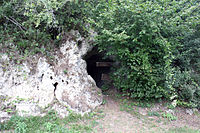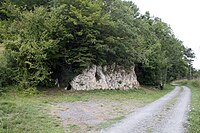Châtelperronian
| Geographical range | Afro-Eurasia |
|---|---|
| Period | Upper Paleolithic |
| Dates | c. 44,500–36,000 BP[1][2][3] |
| Type site | La Grotte des Fées |
| Major sites | Châtelperron |
| Preceded by | Mousterian |
| Followed by | Aurignacian, Périgordian |
| The Paleolithic |
|---|
| ↑ Pliocene (before Homo) |
| ↓ Mesolithic |
The Châtelperronian is a proposed industry of the Upper Palaeolithic, the existence of which is debated. It represents both the only Upper Palaeolithic industry made by Neanderthals and the earliest Upper Palaeolithic industry in Central and Southwestern France, as well as in Northern Spain. It derives its name from Châtelperron, Allier, France (the closest commune to the type site, the cave La Grotte des Fées).
It is preceded by the Mousterian industry, and lasted from c. 45,000 to c. 40,000 BP.[3] The industry produced denticulate stone tools and also a distinctive flint knife with a single cutting edge and a blunt, curved back. The use of ivory at Châtelperronian sites appears to be more frequent than that of the later Aurignacian,[4] while antler tools have not been found. It is followed by the Aurignacian industry.
Scholars who question its existence claim that it is an archaeological mix of Mousterian and Aurignacian layers.[5][6] The Châtelperronian industry may relate to the origins of the very similar Gravettian culture. French archaeologists have traditionally classified both cultures together under the name Périgordian, Early Perigordian being equivalent to the Châtelperronian and all the other phases corresponding to the Gravettian,[7][8][9] though this scheme is not often used by Anglophone authors.
Important sites and lithic production and associations

Large thick flakes/small blocks were used for cores, and were prepared with a crest over a long smooth surface. Using one or two striking points, long thin blades were detached. Direct percussion with a soft hammer was likely used for accuracy. Thicker blades made in this process were often converted into side scrapers, burins were often created in the same manner from debitage as well.
The manner of production is a solid continuation of the Mousterian but the ivory adornments found in association are similar to those made by the Aurignacian.[4] The technological refinement of the Châtelperronian and neighbouring Uluzzian in Central-Southern Italy is often argued to be the product of cultural influence from H. sapiens that lived nearby.
Dispute over disruption of the site
João Zilhão and colleagues argue that the findings are complicated by disturbance of the site in the 19th century, and conclude that the apparent pattern of Aurignacian/Châtelperronian inter-stratification is an artifact of disturbance.[10][11][12] while others think the Châtelperronian itself is an artifact of disturbance. Paul Mellars and colleagues have criticized the analysis of Zilhão et al., and argue that the original excavation by Delporte was not affected by disturbance.[13] Paul Mellars, however, now has concluded on the basis of new radiocarbon dating by Thomas Higham of the decorative artifacts of Grotte du Renne [5] "that there was [a] strong possibility—if not probability— that [decorative artefacts] were stratigraphically intrusive into the Châtelperronian deposits from .. overlying Proto-Aurignacian levels" and that "The central and inescapable implication of the new dating results from the Grotte du Renne is that the single most impressive and hitherto widely cited pillar of evidence for the presence of complex “symbolic” behavior among the late Neanderthal populations in Europe has now effectively collapsed."[6] Subsequent research led by Jean-Jacques Hublin argues using new dates that the Châtelperronian tools were produced by Neanderthals. Unlike Higham's dates, which were taken directly from the decorative material, Hublin's were taken from associated bones. To Higham, dates taken directly from the decorative material are more convincing and should be given priority over those from associated material. To Hublin, Higham's dates were contaminated with varnish applied to the decorative material in the 1960s. Hublin's team subsequently used proteomic evidence to support their conclusion.
In popular culture
Author Jared Diamond argues in his 1991 non-fiction book, The Third Chimpanzee, that Châtelperron may represent a community of Neanderthals who had to some extent adopted the culture of the modern Homo sapiens that had established themselves in the surrounding area, which would account for the signs of a hybrid culture found at the site. Diamond compares these hypothetical Neanderthal hold-outs to more recent Native Americans in North and South America who adopted European technologies such as firearms or domestication of horses in order to survive in an environment dominated by more technologically advanced competitors.[14]
The fifth book of Jean Auel's Earth's Children series, The Shelters of Stone, 2002, and the sixth book The Land of the Painted Caves 2010 are set in this region of modern-day France, during this period.
Type site
The type site is la Grotte des Fées, in Châtelperron.
-
Inside topography
See also
References
- ^ Switek, Brian (2012). "Neanderthals smart enough to copy humans". Nature. doi:10.1038/nature.2012.11673.
- ^ Rocca, Roxane; Connet, Nelly; Lhomme, Vincent (2017). "Before the transition? The final middle Palaeolithic lithic industry from the Grotte du Renne (layer XI) at Arcy-sur-Cure (Burgundy, France)". Comptes Rendus Palevol. 16 (8): 878–93. doi:10.1016/j.crpv.2017.04.003.
- ^ a b Higham, Thomas; Douka, Katerina; Wood, Rachel; Ramsey, Christopher Bronk; Brock, Fiona; Basell, Laura; Camps, Marta; Arrizabalaga, Alvaro; Baena, Javier; Barroso-Ruíz, Cecillio; Bergman, Christopher; Boitard, Coralie; Boscato, Paolo; Caparrós, Miguel; Conard, Nicholas J; Draily, Christelle; Froment, Alain; Galván, Bertila; Gambassini, Paolo; Garcia-Moreno, Alejandro; Grimaldi, Stefano; Haesaerts, Paul; Holt, Brigitte; Iriarte-Chiapusso, Maria-Jose; Jelinek, Arthur; Jordá Pardo, Jesús F; Maíllo-Fernández, José-Manuel; Marom, Anat; Maroto, Julià; et al. (2014). "The timing and spatiotemporal patterning of Neanderthal disappearance". Nature. 512 (7514): 306–309. Bibcode:2014Natur.512..306H. doi:10.1038/nature13621. PMID 25143113.
- ^ a b d'Errico, Francesco; Zilhão, João; Julien, Michèle; Baffier, Dominique; Pelegrin, Jacques (1998). "Neanderthal Acculturation in Western Europe? A Critical Review of the Evidence and Its Interpretation". Current Anthropology. 39: S1 – S44. doi:10.1086/204689.
- ^ a b Higham, Thomas; Jacobi, R.; Julien, Michèle; David, F.; Basell, Laura; Wood, Rachel; Davies, W.; Ramsey, Christopher Bronk (2010). "Chronology of the Grotte du Renne (France) and implications for the context of ornaments and human remains within the Chatelperronian". Proceedings of the National Academy of Sciences. 107 (47): 20234–9. Bibcode:2010PNAS..10720234H. doi:10.1073/pnas.1007963107. PMC 2996711. PMID 20956292.
- ^ a b Mellars, Paul (2010). "Neanderthal symbolism and ornament manufacture: The bursting of a bubble?". Proceedings of the National Academy of Sciences. 107 (47): 20147–20148. Bibcode:2010PNAS..10720147M. doi:10.1073/pnas.1014588107. PMC 2996706. PMID 21078972.
- ^ Jordá Cerdá, Francisco; Pellicer Catalán, Manuel; Acosta Martínez, Pilar; Almagro-Gorbea, Martín (1986). Prehistoria. "Historia de España" series, vol. 1 (in Spanish). Gredos. ISBN 84-249-1015-X.[page needed]
- ^ Peñalver Iribarren, Xabier (1996). Euskal Herria en la Prehistoria (in Spanish). Orain. ISBN 84-89077-58-4.[page needed]
- ^ Alimen, Marie-Henriette; Steve, P. Marie-Joseph (1989) [1970]. Prehistoria. "Historia Universal Siglo veintiuno" series, vol. 1 (in Spanish) (20th ed.). Siglo XXI Editores / Fischer Bücherei. ISBN 84-323-0034-9.[page needed]
- ^ Zilhao, João; d'Errico, Francesco; Bordes, Jean-Guillaume; Lenoble, A.; Texier, J.-P.; Rigaud, J.-P. (2006). "Analysis of Aurignacian interstratification at the Chatelperronian-type site and implications for the behavioral modernity of Neandertals". Proceedings of the National Academy of Sciences. 103 (33): 12643–8. Bibcode:2006PNAS..10312643Z. doi:10.1073/pnas.0605128103. PMC 1567932. PMID 16894152.
- ^ Zilhão, João; et al. (2008). "Like Hobbes' Chimney Birds" (PDF). PaleoAnthropology: 65–67.
- ^ Bordes, Jean-Guillaume; Teyssandier, Nicolas (2011). "The Upper Paleolithic nature of the Châtelperronian in South-Western France: Archeostratigraphic and lithic evidence". Quaternary International. 246 (1–2): 382–8. Bibcode:2011QuInt.246..382B. doi:10.1016/j.quaint.2011.08.001.
- ^ Mellars, Paul; Gravina, B.; Ramsey, Christopher Bronk (2007). "Confirmation of Neanderthal/modern human interstratification at the Chatelperronian type-site". Proceedings of the National Academy of Sciences. 104 (9): 3657–3662. Bibcode:2007PNAS..104.3657M. doi:10.1073/pnas.0608053104. PMC 1805566. PMID 17360698.
- ^ F. Jared Diamond, The Third Chimpanzee: The Evolution and Future of the Human Animal Harper Perennial. 2006. ISBN 978-0-06-084550-6[page needed]
External links
- Picture Gallery of the Paleolithic (reconstructional palaeoethnology), Libor Balák at Czech Academy of Sciences, Institute of Archaeology in Brno, Center for Paleolithic and Paleoethnological Research





